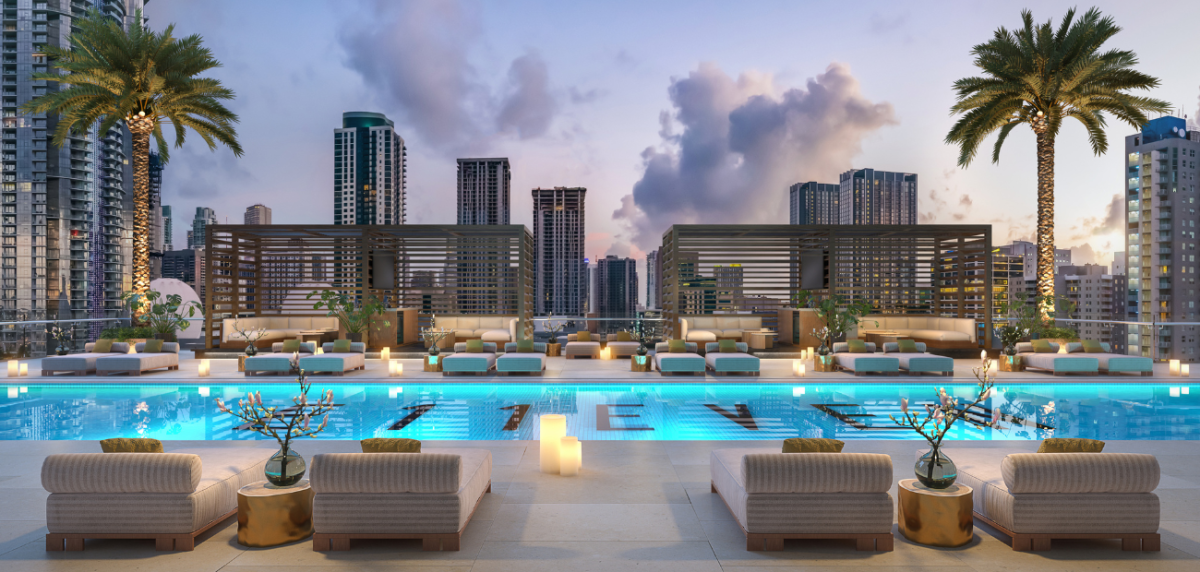3 Key Takeaways
- Swimming pools remain a favorite outdoor amenity, across asset classes and climates.
- Residents should weigh whether they’ll use amenities since the cost is factored into prices.
- Some amenities, like parks, views and access to public transit, are integral to location and quality of life.
For years, developers have likened amenities to icing on a cake. When considerations like location and price are comparable, renters and buyers alike may make their decision based on the amenity package. As growing awareness of the mental and physical health benefits of fresh air and nature continues, many offerings focus on the outdoors.
Outdoor amenities depend on many factors: the property’s size, location, configuration, and so on. Most developers and consultants take inventory of what’s already in a neighborhood, ensuring their building’s amenities account for what’s nearby and what the community needs, says Mary Cook, founder of commercial design firm Mary Cook Associates in Chicago. “Is it across from a fitness center with a pool that can be used, and who will live in the building?” she asks. “Is it mostly tech workers doing remote work in the building or medical and educational personnel heading off each day?”
A building’s asset class also affects choices. Luxury condos and Class A rental buildings typically offer more, and fancier, options. But many developers focused on smaller and Class B, affordable and workforce housing deliver similar favorites. Douglas Enclave, a 199-unit affordable rental building in Miami developed by The Astor Companies, includes an amenities deck on its fourth floor, with a pool, deck, sun chairs and views of downtown.
Due to cost and supply issues with land, labor and materials, many developers now prioritize selections. Catering to residents' wants and needs is important, says Jacob Goldman, principal and founder of Beam Architects. “We’re hyper-focused on understanding the amenities that hold the most appeal for end-user residents. By doing so, we can deliver the highest value to our developer client and ensure a quality living experience,” he says.
Help clients decide what matters most to them by first understanding what multifamily spaces offer.
The Latest and Greatest
The more innovative an amenity, the better it is to attract residents who may seek what other buildings don’t have. The amenity may also reflect a developer’s values. Beekeeping is adding a buzz to buildings designed around about environmental conservation, with managers often retaining a third-party vendor to add apiaries and tend to bees. The Best Bees Company offers residents (as well as hotel guests and office tenants) a sustainability experience they can engage in, says Paige Mulhern, creative director. The Boston-based company installs hives, manages and researches bees and offers events such as honey tasting, wax crafting and educational hive tours in more than a dozen cities.
Pools
There’s less differentiation these days in what’s available by climate, evident in outdoor pools installed even in cold-weather locations. Developer Henry Torres, CEO and president of The Astor Companies in Coral Gables, Fla., says that “nine out of 10 times a pool is the most important amenity.” Developer Ryan Shear, managing partner of Property Markets Group in Miami, agrees. “Most developers today would be crazy to do a building without a pool. But the amount of real estate square footage and dollars put toward them varies,” he says.
In Miami, his company is currently building the E11EVEN Hotel & Residences, which will set a new standard with its Las Vegas–style extravaganza of 18 pools on a 40,000-square-foot, double-decker deck 120 feet in the air. Affordable and workforce projects follow the trend. In the San Diego area, Edward Ring, CEO of New Standard Equities Inc., added a pool because the building had no water view and required a drive to get to the ocean.
Views and Parks
Views are played up by outdoor amenities. BEAM Architects’ chief designer Naftali Silverberg took care in designing a nine-story building on Ocean Parkway in Brooklyn using glass railings on the rooftop to avoid obstructing water views.
At the 500 Crawford building in downtown Houston, across from Minute Maid stadium where the Astros play, the Finger Companies designed its Class A, mid-rise rental building with a retractable roof to make viewing the park easier from a sixth-floor lounge and balcony. “You can hear the crowd roar. One ball hit out of the park landed on our property,” says Hunter Wagner, executive vice president of asset management.
In Bremerton, Wash., Ring renovated a Class B building for workforce housing with a new deck to savor views.
Parks also command interest due to interest in greenery. Mansueto Office transformed The Belden-Stratford in Chicago’s Lincoln Park neighborhood into a luxury multifamily rental with a renovated roof deck. The owner also considers the adjacent Lincoln Park Zoo and conservatory part of its outdoor amenity package, says Ted Fahey, vice president of real estate. Similarly, Blue Onyx Companies bought a historic building to adapt and expand in Paterson, N.J., because of the Passaic River site and adjacent park.
Passive Versus Active Use
In the ideal scenario, developers design spaces with comfortable furnishings and lighting for those who want to relax. For some renters and buyers, outdoor spaces with a focus on leisure are just as important as spaces designed for activity. Alison Mills, vice president of design and development at CRG, says her firm likes to break large areas into smaller zones such as a place to grill, which might be next to an indoor lounge. Developers also favor opportunities for shade and sun in different climates, she says. The Finger Companies’ Quin rental building in suburban Schaumburg, Ill., gained a 2.5-acre residents’ park with benches, lighted paths, walking trails and two dog parks. The company often brings in food trucks.
Activating outdoor space tends to keep residents outside for longer periods and in different seasons. A variety of activity spaces are popular, including putting greens, oversized movie screens, greenhouses and vegetable gardens, pingpong tables, corn hole games, and playsets. “Many outdoor amenity spaces become the equivalent of a playground,” Shear says.
Outdoor space also creates an opportunity for community building within a complex. Devin Wirt, co-founder and chairman of the board for Connexus Living, has advised communities how to activate spaces to bring residents together. "Owners and operators have seen that if you have five or more friends in a community, then your resident is more likely to renew their lease," Wirt says. Louis DeVos, vice president of property management with Woodmont Properties in Fairfield, N.J., says his firm has conducted focus groups to hear what residents value and find missing, then makes changes. He says activity-based amenities like walking trails or instructor-led yoga classes are in; pet spas hold less value for some.
Parking
Parking has become an amenity, especially in urban buildings where street and garage spots are at a premium or costly. Outdoor surface lots are more common in many buildings while covered or underground parking is favored for condos and Class A rental buildings. More buildings are adding EV charging stations or the infrastructure to install them later, DeVos says. CEO Levi Kelman of Blue Onyx included one free parking spot per unit in his Paterson building since he knew paying for space would burden residents.









